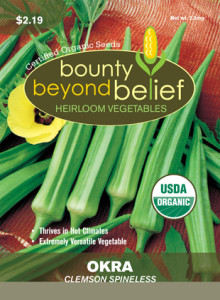Okra Is Not As Yucky As Some Might Think
History of Okra and Okra Recipes
By Engrid Winslow
If you grew up in the South, as I did, you loved okra as an essential ingredient in gumbo. If you didn’t then you might think it is “slimy” but okay if coated in batter and deep-fried. Well, you have been treating this amazing vegetable all wrong. First of all, the plants are really pretty and the flowers are fabulous, looking a lot like a hibiscus bloom, and can be grown as a 3-4 foot tall annual flower. Try our Clemson Spineless Okra Recipes!
Okra probably originated somewhere around Ethiopia and was cultivated by the ancient Egyptians around the 12th century B.C. Its cultivation spread throughout North Africa, Arabia and the Middle East. The seed pods were eaten cooked, and the seeds were toasted and ground and used as a coffee substitute.
The plant spread around the shores of the Mediterranean Sea and eastward and was introduced to the Americas by ships plying the Atlantic slave trade in the mid-1600s when its presence was recorded in Brazil. It was further documented in Suriname in 1686. Okra may have been introduced to southeastern North America from Africa in the early 18th century. By 1748, it was being grown as far north as Philadelphia. Thomas Jefferson noted it was well established in Virginia by 1781.
It’s best to grow okra yourself if you can (or purchase them directly from a farmer) to ensure that the pods are fresh, tender and not overly large. Okra pods are best when harvested at 1-2 inches. Any larger than that and they are fibrous and not so tasty. The plants are easy to grow in most climates as long as they are planted after the danger of frost is past. They are prolific, grow quickly, and several plants can produce a handful or two of the pods nearly every day.
Store them in the vegetable bin of your refrigerator for up to 4 days until you have enough to prepare one of these great okra recipes. Okra is especially adept at soaking up surrounding flavors, making great for Indian and Asian dishes. Give okra a second chance and you might just be surprised.
One of the best ways to cook okra is to toss the pods with a little olive oil, salt and pepper and spread on a rimmed baking sheet. Roast at 400 degrees for 12- 15 minutes, shaking pan half-way through until the pods are lightly browned on the edges.
Pan-Fried Clemson Spineless Okra with Indian Spices
(Serves 4 as a side dish)
25-30 medium-sized okra pods, sliced 5 TBL butter
¼ tsp ground ginger ¼ tsp cumin
¼ tsp ground coriander salt and pepper to taste
Melt the butter in a skillet, Add okra and spices and sauté until okra is soft, 15-20 minutes. Season with salt and pepper before serving.
Picadilly Clemson Spineless Okra
(Serves 4-6 as a side dish)
2 Qt. fresh okra, chopped 1 medium onion, chopped
1 red bell pepper, chopped 1 1 lb. can of crushed or chopped tomatoes
¼ tsp sugar ¼ tsp olive oil
Salt and black pepper to taste
Sauté the onion and bell pepper in the olive oil for 4-5 minutes on medium heat, stirring frequently until softened. Add the tomatoes, okra, sugar, salt and pepper and cook, covered, over low heat for 45 minutes. Stir occasionally. Check and correct seasoning before serving. May be frozen.

Leave a Reply
Want to join the discussion?Feel free to contribute!